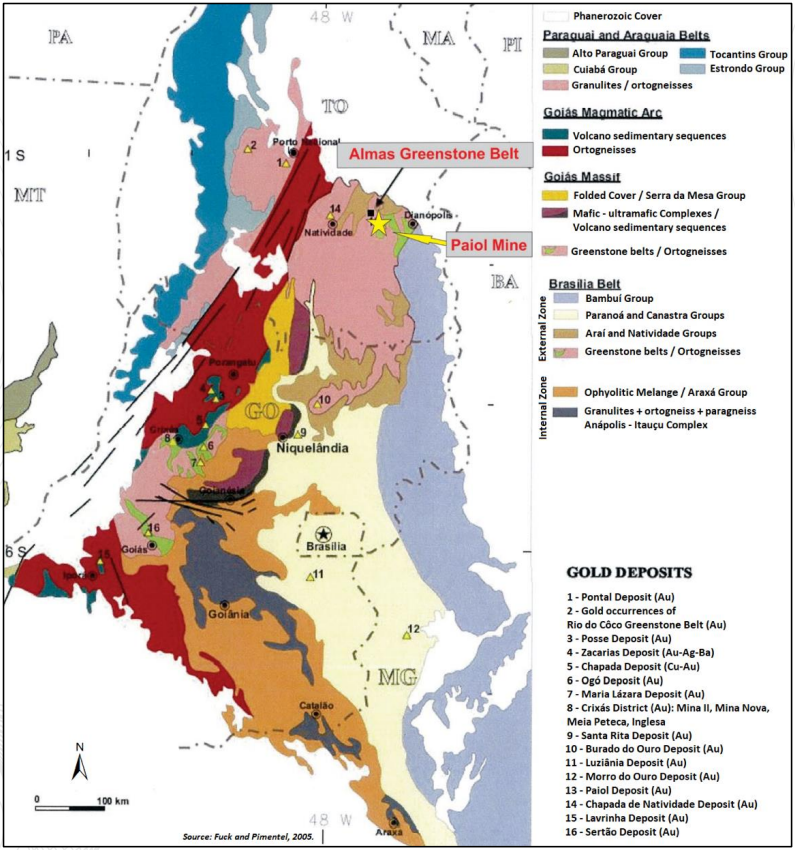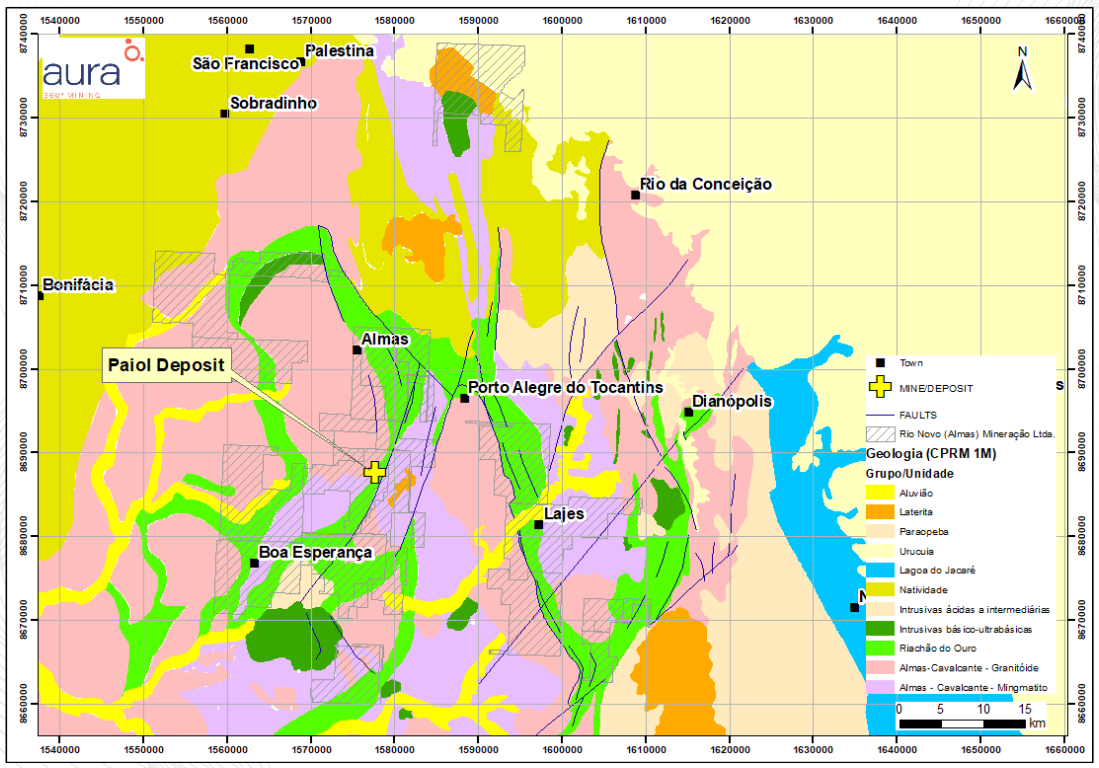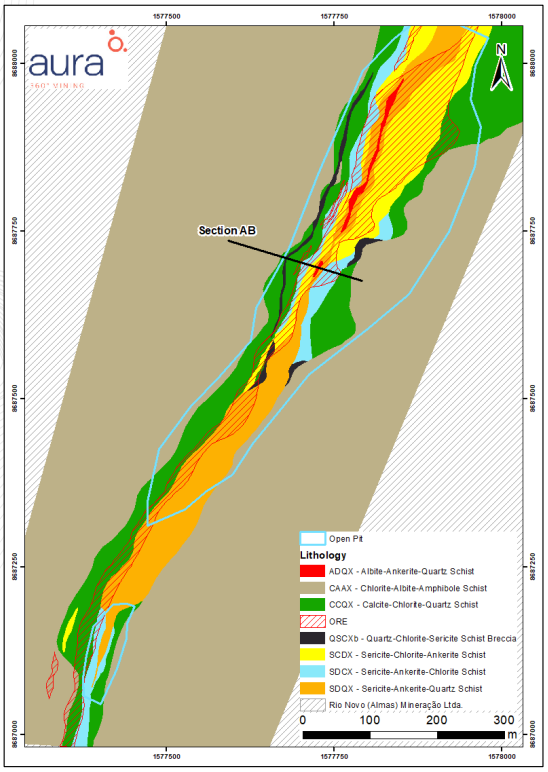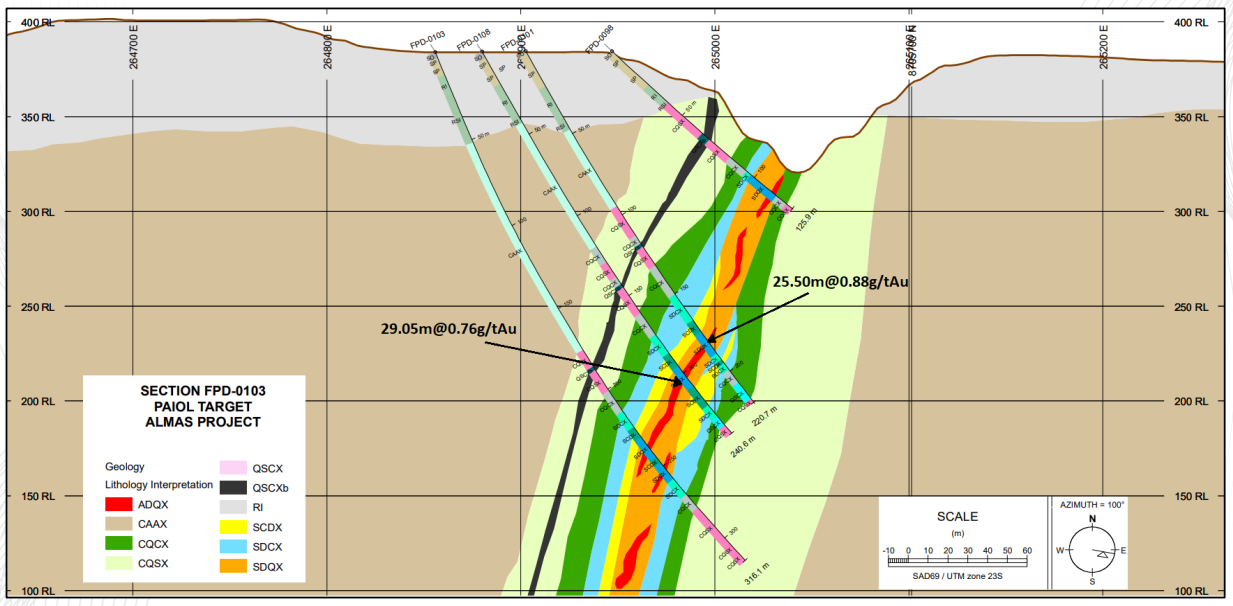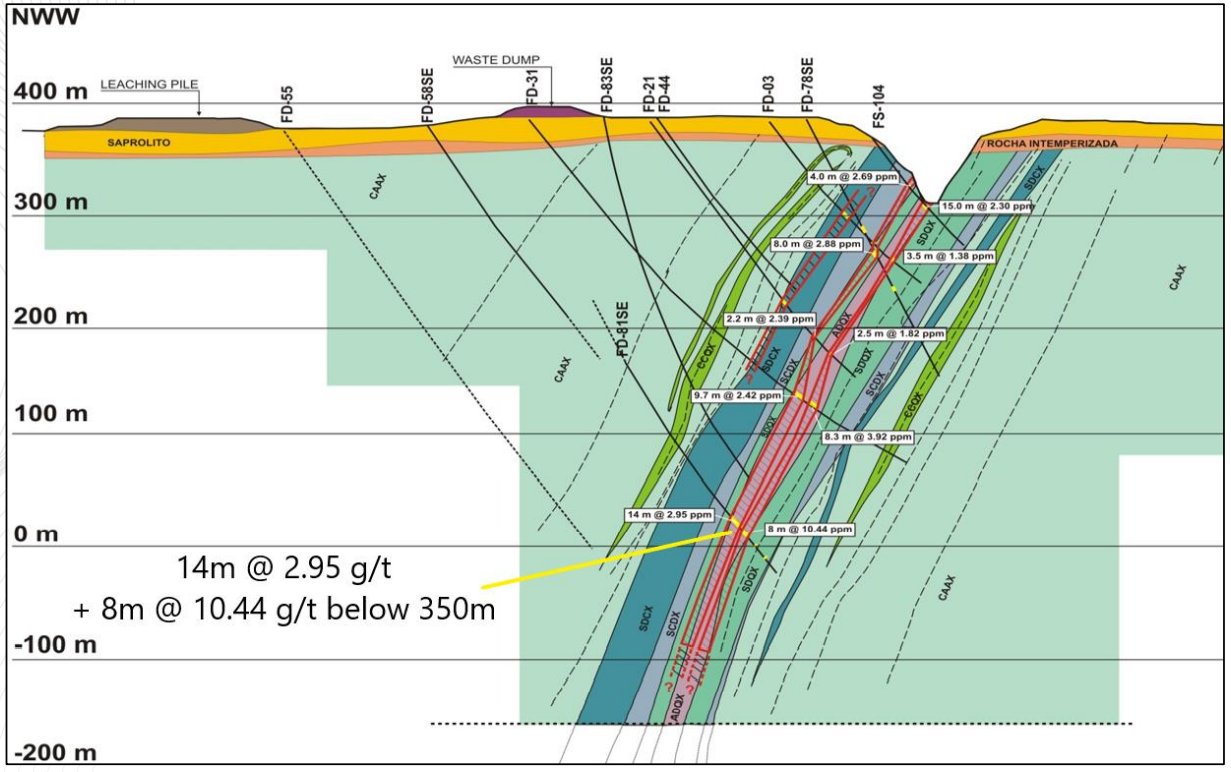The Paiol deposit is in the south-central region of Tocantins State, Brazil. The deposit area lies south of Almas (population 7,000), a small town approximately 300 km southeast of Palmas, the Tocantins State Capitol and 45 km west of Dianópolis, a regional commercial center. The Almas town site is accessed by State Highways TO-010, TO-070 and TO-050 from the state capital of Palmas, via Porto Nacional to Natividade – a trip of approximately four hours by car. Palmas, the capital city of Tocantins State (population 306,000) has all the major facilities for industrial support as well as State governmental agencies. Palmas supports a regional airport with scheduled commercial service departing several times a day to Brasilia and São Paulo. The principal commercial center in the Almas region is Dianópolis, 45 km east of the Almas town site. There are commercial flight options from Barreiras airport, with flights to Brasília, Belo Horizonte and Salvador. Barreiras is about four hours by car to Almas. Barreiras (population of 156,000) and Luiz Eduardo Magalhães (population of 90,000), located east of Almas, with distances of 280 and 190 km respectively., On the BR-242 and TO-040 highways, are cities with good infrastructure, service companies, commerce and industries. From the city of Almas, the three target areas may be reached by all-weather gravel roads, well maintained by the local government. The 17 km distance from Almas to the Paiol mine is traversed by light vehicle in approximately 20 minutes. Almas may also be reached by chartered aircraft as the local government maintains a small gravel airstrip south of the town site. At present, there is no rail service into the Almas area.
History
Gold mining in the Almas area began in the 1700s during colonial times when slave labor was used to extract gold from near-surface oxide zones. In more recent times, garimpeiros (artisanal miners) expanded the earlier excavations. In 1977 the exploration arm of VALE identified some potentially prospective volcano-sedimentary sequences of Archean age in the region. Further exploration by VALE in the mid- to late-1980’s led to discoverie at Paiol. In 1996, VALE commenced mining at the Paiol deposit.
Gold has been the primary target of exploration in the district. Discoveries thus far, have been made by a combination of mapping and soil sampling, followed by drilling. To date, exploration has primarily targeted near-surface gold anomalies and is therefore still in the early stages. The major exploration milestones are highlighted below:
- 1985: VALE and METAGO, agreed to jointly explore the area.
- 1985 to 1987: Several targets were identified during this phase of exploration: Paiol, Cata Funda, Vira Saia, Morro do Carneiro, Refresco, Vieira, Ijuí, Mateus Lopes and Cemitério.
- 1986: Initial drilling and discovery of the Cata Funda deposit.
- 1987: Discovery of Paiol deposit.
- 1996: VALE reports initial resource estimates for the Paiol deposit.
- 1996 to 2001: VALE conducts mining of the Paiol deposit.
- 2006 – Mineração Apuã commences exploration.
- 2008 to 2010: Rio Novo conducts confirmation drilling, resulting in a resource estimate, reported as an NI 43- 401 Technical Report in February 2010.
- 2010 to 2011: Core drilling initiated by Rio Novo for confirmation and expansion of the Paiol and Cata Funda resource areas as well as exploration of nearby targets.
- 2011: Discovery of the Vira Saia deposit 5 km north of Paiol
- 2011 to 2012: Infill drilling and resource modeling at Vira Saia brought additional resources and enhanced the overall Almas Gold Project, leading to completion of a Preliminary Economic Assessment (PEA) in March 2012.
- 2013 & 2016: RPM completed two feasibility study level reports (NI 43-101).
Regional Geology
The Tocantins Structural Province (TSP), located in the central region of Brazil, constitutes a system of Brazilian orogens, characterized by folding and thrusting belts called the Brasília, Paraguay and Araguaia Belts, resulting from the convergence and collision of three continental blocks: Amazonian Craton, to the West; Cráton São Francisco, to the East; and Cráton Paranapanema, to the Southwest, covered by the rocks of the Paraná Basin, this one with its limits inferred through gravimetric data. The foundation of the province is composed of Archaean and Paleoproterozoic terrains reactivated during the Brazilian Cycle (Delgado et al., 2003). In the final stages of the Brazilian Cycle, the gravitational collapse, exhumation and / or extrusion of the orogens, which occurred up to the Upper Ordovician have been related as a transition stage between conditions of active convergent tectonics to conditions of intraplate stability, with the beginning of the Paleozoic basins.
These phanerozoic coverings, in almost all Paraná, Parnaíba, Bananal and Pantanal Mato-Grossense basins, hide large parts of this system.
The TSP is compartmentalized in the Cráton São Francisco for small exposures of the basement and the extensive sedimentary coverings, Brasília Belt, built on the west side of the craton, divided into Zones Internal and External, Goiás Massif and Goiás Magmatic Arch.
The Brasília Belt is a well-preserved orogenic belt, consisting of a thick set of passive-edge sedimentary rocks associated with volcanic rocks, a mixture of ophiolitic, calc-alkaline volcanic arch-type rocks and intrusive S-type granites. The degree of metamorphism increases to the West, moving from low-grade non-metamorphic and metamorphic rocks, on the São Francisco Craton border to the East, to high-temperature amphibolite facies and ultra-high-temperature granulites in the metamorphic nucleus, decreasing again for amphibolite and green schist facies in the rocks of Goiás Magmatic Arch.
The tectonic zoning of the Brasília Belt is marked by a foreland transition from the São Francisco Craton to the East, External and Internal allochthonous zones formed in an old passive Neoproterozoic margin of the paleocontinent São Francisco-Congo to the West, for the exotic terrains of the Goiás Massif and the Goiás Magmatic Arch.
In the central part of the Tocantins Province the following Precambrian domains are recognized: Crixás – Goiás Archean Terrain, interpreted as a small allochthonous continental block; Paleoproterozoic sialic base, represented by orthogneisses and metavolcanosedimentary sequences, in the region of Almas – Dianópolis; the Anápolis – Itauçu High-grade Complex; Paleo-Mesoproterozoic Mafic Ultramafic Bedded Complexes (Barro Alto, Niquelândia, Canabrava) and associated metavolcanosedimentary sequences; and Goiás Magmatic Arch, of the Neoproterozoic.
The External Zone of the Brasília Belt is composed of Mesoproterozoic and Neoproterozoic metasedimentary units represented by the Araí and Natividade Groups, Paranoá and Canastra Groups, as well as portions of the Archean-Paleoproterozoic basement that show rejuvenation due to the Brazilian tectonics.
The Northern and Southern portions of the outer zone of the Brasília Belt represent two contrasting styles of proximal continental passive margins. In its Northern part, between Alto Paraíso de Goiás and Natividade / TO, it consists of a large Paleoproterozoic crustal block, partially covered by a gently folded rift sequence of the Arai Group metasedimentary rocks (1.77 Ga and younger). This block is limited to the East for thrust faults that places it over the rocks of Bambuí group. To the South of Alto Paraíso de Goiás, the Araí Group is inconsistently covered by the Paranoá Group, which is also pushed over the Bambuí Group to the East.
The Natividade Group is represented by quartzites, conglomeratic quartzites, phyllites, schist quartz, marbles and the Araí Group, composed of a set of metamorphic and metavolcanic rocks, of low metamorphic degree, superimposed on the Aurumina Suite and the Ticunzal Formation, constitutes a succession deposited in an intracontinental rift basin, whose evolution started before 1.77 Ga in the Paleoproterozoic.
The Paranoá Group corresponds to a psammite-pelite-carbonated succession deposited under platform conditions. Its deposition is interpreted as occurring in the Mesoproterozoic (1,542 to 1,042 Ma). Its age is corroborated by its stratigraphic position (it occurs on sediments from the Araí Group post-rift phase and under the Bambuí Group pelites and carbonates), by the presence of conical stromatolites (conophyton ) and isotopic data.
The Canastra Group is considered a lateral equivalent of the Paranoá Group, with more marked metamorphism, and occurring in the south-central part of the Brasília Belt.
The Internal Zone includes allochthonous units of the Araxá Group, as well as portions of the basement heavily involved in the Brazilian tectonics (Goiás Massif, with remnants of greenstone belts). There are also granulitic mafic-ultramafic complexes and Proterozoic volcano-sedimentary sequences.
The Pre-Cambrian lands, which constitute the Tocantins Structural Province, are characterized by folded and metamorphized supracrustal belts, exposed along the edges of the Amazonian Cratons (Paraguay and Araguaia Belts) and São Francisco (Brasília and Uruaçu Belts). Amid the folded belts, there is the so-called Goiás Massif, a massif of crystalline rocks of varied nature and age, whose geotectonic significance is still poorly understood due to the scarcity of geochronological data, and geophysical and structural information.
The Massif of Goiás is considered an allochthonous microplate, added to the Western margin of the Brasília Belt during the last stages of evolution of the Neoproterozoic orogenesis. It consists of a set of typical TTG granite-gneiss complexes and narrow bands of greenstone-belt sequences. The granite-gneiss lands are comprised of orthogneisses that, in the Northern part of the land, comprise the Tapir, Caiamar, Moquém and Hidrolina and, in the South, the Caiçara and Uvá complexes.
The deposit area occurs within the Goiás Massif: an Archean-to-Paleoproterozoic granite-greenstone terrane. The greenstone belt lies within the Almas-Dianópolis Terrane on the Western block of the Goiás Massif.
Tocantins Province Tectonostratigraphic Map
There are two metamorphic events, one, M1, related to Dn, restricted to the greenstones and M2 related to shear zones Dn+1, which affects all units of the Almas-Dianópolis Terrane. Regional metamorphic paragenesis M1 varies from amphibolite to greenschist facies and the main paragenesis in metabasalts is amphibolite + plagioclase ± chlorite ± epidote. M2 paragenesis is characterized by amphibolite + albite + epidote ± white mica ± chlorite, occurring in the greenstones, granite-gneiss complexes and basic-ultrabasic intrusions. The amphibolite composition of M1 paragenesis varies from ferric actinolite to tshermakitic hornblende, while the plagioclase varies from albite to andesine.
The orogenic gold deposits are characterized by the predominance of quartz veins, containing sulfides (≤3-5%), mainly Fe sulfides and carbonate minerals (≤5-15%). The veins may contain albite, white mica, chlorite, tourmaline in the greenschist domains; or amphibole, diopside, biotite-phlogopite, tourmaline and garnet in the amphibolite facies. The veins evolve a continuous system with an extension of approximately 1-2 km and little change in mineralogy or intensity of mineralization.
Hydrothermal alteration presents more pronounced lateral variation than vertical variation in the plane of mineralization. The hydrothermal mineral assembly and the intensity of mineralization varies according to the type of embedding rock and crustal level of alteration. Regionally, the presence of calcite, dolomite, ankerite, pyrite, chlorite, sericite and fuchsite is recognized in the greenschists facies, and calcite, pyrrhotite, Ca amphiboles, diopside, coarse, biotite and feldspar in higher metamorphic degrees. Sulfidation is more intense in banded iron formations and carbonation is dominant in mafic and ultramafic embedding rocks. Significant enrichment of SiO2 in the mineralized zones is evidenced by the presence of large amounts of quartz veins.
Always associated with shear zones (Dn+1), the mineralization is essentially hosted in the granite-gneiss complexes and banded iron and greenstone amphibolite formation. In all occurrences, gold is hosted by segregations and / or quartz veins bordered by hydrothermal alteration zones, mainly sericitization and argilization in gneissic granite, chloritization, sericitization and carbonatization in amphibolite and carbonation, sulfidation and tourmalinization in banded iron formation. The main deposits are Vira-Saia, in granite-gneiss and Córrego Paiol, in amphibolite.
Tocantins Province Tectonostratigraphic Map
Local Geology
Deposit is situated in an historical gold mining area with numerous small artisanal mines (garimpos). Gold occurs in sheared metavolcanic rocks within the greenstone sequence, as well as in sheared felsic intrusive rocks. The rocks are, in general, Paleo-Proterozoic in age (~2.2 billion years old) and have undergone regional metamorphism ranging in intensity from greenschist- to amphibolite-facies. The metamorphism resulted in deep-seated, shear-hosted, mesothermal, gold deposits which have more recently been referred to as orogenic gold deposits. The gold-mineralized zone occurs in the core of hydrothermal alteration zones, generally associated with variable amounts of quartz, carbonate, albite, sericite and sulphide minerals.
The Almas-Dianópolis terrane, in the Western block of Goiás Massif, comprises several narrow greenstone belts surrounded by granite-gneiss complexes. The volcano-sedimentary sequence of Riachão do Ouro Group is composed at the base by the Córrego do Paiol formation and at the top by the Morro do Carneiro formation. Late granitic intrusions cut the supracrustal sequence. These rocks were metamorphosed to amphibolite facies during a regional tectonic-metamorphic event (Dn) and then retrogressively altered to greenschist facies assemblages, followed by a subsequent hydrothermal alteration phase linked to late strike-slip shear zone events (Dn+1).
Córrego do Paiol Formation is composed of dominant metabasalts, locally pillowed, and rare small occurrences of ultramafic metavolcanic rocks. The metabasalts are essentially massive dark green fine-grained amphibole-plagioclase-chlorite-epidote schists. Moreover, at contacts with granitoids actinolite schists are present, probably as a result of contact metamorphism. Ultramafic rocks are tremolite-chlorite schists that crop out near Dianópolis. These metabasalts correspond to high-Fe tholeiites. The ultramafic volcanic rocks are high-Mg tholeiites with komatiitic affinity. The pillowed metabasalts are indicative of a submarine deposition.
The upper Morro do Carneiro Formation consists mainly of a monotonous seqence of sericitic phyllites with carbonaceous material rich layers and more rarely chlorite-bearing layers. It also includes beds of variable thickness of more abundant hematite-magnetite banded iron formations; quartzites with magnetite bearing layers; tourmaline quartzites; and metacherts. Iron formations and metacherts are exposed near the contact with the Córrego do Paiol Formation South of Almas.
The granitoids are classified into two suites differentiated by their predominant mafic mineral. Suite 1 is comprised of hornblende-predominant tonalites, granodiorites, trondhjemites, quartz-monzodiorites and quartz-diorites. Suite 2 is composed of biotite-predominant tonalites, trondhjemites, granodiorites and monzogranites. Both suites have calc-alkaline tonalitic-trondhjemitic chemical affinities.
The most notable structural feature of Terreno Almas-Dianópolis is the distribution of greenstone belts and granite-gneiss complexes. Costa et al. (1976) were the first to recognize the Y-shaped distribution of the belts, mainly linear, in the North-South direction with branches to the Northeast and Northwest. They also have curved contacts around the granite-gneissic complexes. The complexes have geometry partially obliterated by directional shear zones that truncate the geological contacts and affect the metasedimentary rock coverings of the Natividade, Paranoá and Araí groups, the oldest structures generated in the Dn event present, in greenstones, a subvertical schistosity with features shear locations, which tend to be parallel to the contour between greenstones and granite-gneissic complexes, tight vertical folds and sub horizontal mineral lineation.
Younger structures include directional shear zones Dn + 1 with distal movement of main direction N20-30E and subsidiary directions N0-10E and N10-20W. These Dn + 1 shear zones have been related to the evolution of the Almas-Dianópolis Terrain. Dn_1 shear zones were not observed in the rocks of the Bambuí and Natividade groups in the region. Two other directions of shear zones are observed N35-50W with sinistral movement and N40-65E with distal movement, forming a conjugated pair resulting from East-West compression. The greenstones are arranged in the directions N10-35E, N10-20W, N45W and NS.
The structural control of the mineralization in the Almas-Dianópolis Gold District is the most important control factor. In most cases gold is concentrated on second and third order structures located near regional deformation zones, especially the transcrustal zones.
Most gold bearing structures present a brittle-ductile nature but can be from different styles:
- Brittle-ductile reverse fault zones, from low to high angle.
- Fracture sequences, stockwork systems or brecciated zones in competent rock.
- Foliation with cleavage zones.
- Fold hinge zones and associated reverse faults in tight folds.
Alteration zones are symmetrical with respect to the shear zones, typical of classic greenstone alteration, including: chloritization (distal zone), sericitization (potassic alteration) and silicification, widespread carbonatization and sulphidation (pyrite and/or pyrrhotite) (proximal zone). These alteration zones are developed around shear zones cutting the mafic-to-intermediate volcanic and volcaniclastic rocks previously affected by amphibolite facies metamorphism. The hydrothermal alteration presents more lateral than vertical variation within the mineralization structures.
Gold mineralization is found in three groups of rocks, in metabasalts of the Córrego Paiol Formation, in metasedimentary rocks of the Morro do Carneiro Formation and in granite-gneiss complexes.
Several occurrences of gold are hosted in the metabasalts, mainly south of Almas, the most important being that of the Córrego Paiol mine. The occurrences hosted in metasedimentary rocks are dominant in the southern portion of the terrain, Conceição do Tocantins region, while the occurrences in granite-gneissic rocks are distributed throughout the granite-greenstone terrain.
Gold in the Almas Greenstone Belt occurs in three different associations:
- Gold associated with hydrothermally-altered shear zones in basic to intermediate volcanic rocks;
- Gold associated with hydrothermally-altered banded iron formation;
- Gold associated with smoky quartz veins in sheared granite gneiss.
Gold mineralization is closely associated with mylonitic banding in shear zones that cut mafic-to-intermediate volcanic rocks, schists and granite-gneiss, the latter being noted at the Vira Saia deposit. Gold occurs as free gold and as gold inclusions within sulfide minerals. The stronger gold mineralization is associated with faults and shear zones.
District Geology of the Almas Belt showing Garimpos
The structural control of mineralization at the Paiol and Cata Funda deposits is related to strike-slip shear zones (Dn+1 event) and later remobilization into radial, brittle-ductile zones (Dn+2 event) (Ferrari & Choudhuri 2000). The ore shoots are believed to have formed where the mylonitic foliation (Sn+1.) is cut by extensional brittle faults of the Dn+2 event (Ferrari and Choudhuri 1999a). These faults possibly served as conduits for the transport of gold-rich hydrothermal fluids.
Deposit geology.
The Paiol deposit is in the middle portion of the Almas Belt, approximately 500 m east of the metabasalt/ intrusive contact. The metabasalts that host mineralization display a primary foliation of 280° azimuth with a 65° dip. The mineralization is a result of hydrothermal alteration processes controlled by shear zones. Based on the drilling data, the altered rocks form a trend at least 1,400 m long, varying from 40 m to 140 m wide from South to North, respectively.
The mineralization is continuous and confined to certain parts of the hydrothermal alteration package. The higher potential of the deposit is in the north-central part of the deposit where an intersection between the main shear zone and a secondary north-south shear zone has been interpreted.
Hydrothermal alteration assemblages at Paiol show a symmetrical zonation inward from the margin to the center of the structure: chloritization, sericitization, carbonatization, albitization and silicification. Sulfide minerals occur as millimetric to sub-millimetric grains, not exceeding more than 5% by volume.
The paragenesis of hydrothermal minerals is represented by chlorite, sericite, ankerite, calcite, albite, quartz, pyrite, (pyrrhotite) and rare tourmaline - epidote. Locally, late stage calcite-pyrite veinlets represent the final stage of alteration. The alteration paragenesis is syn-to-late-orogenic, suggesting that hydrothermal events were concomitant with tectonism.
The main Paiol ore body has overall dimensions of approximately 650 m in the down dip direction, 1,300 m along strike and averages 27 m in thickness. Overlying bedrock is 1 to 5 m of brick red, argillaceous soil with sparse, weakly magnetic, pisolites. Beneath the soil horizon is 12 to 35 m of light red, yellow to ocher-colored saprolite, locally mottled and kaolinized.
Locally relict textures and zones of deeply weathered rock may be preserved in the saprolite zone. The saprolite overlays 2 to 15 m of weathered and oxidized bedrock containing Mn-oxide minerals in fractures and on foliation planes. Locally boxwork texture after sulfide minerals is noted.
The Paiol geological map was compiled by surface projection of drilling data displayed on cross sections of which. The map shows the continuity of the mineralization from North to South where the main alteration assemblage of albite-ankerite-quartz schist represents the center of the hydrothermal system, indicated in red. The cross sections show the thickness of the Paiol Deposit, with significant intersections with high-grade at greater depth (below 350 m).
Geological Map – Paiol Deposit
Geologic Cross Section A-B of Paiol Deposit
Geologic Cross Section of Paiol Deposit
Grade-thickness section of Paiol Deposit
Mineral Resource & Reserve Estimate
Mineral Resources have an effective date of December 31, 2020.
The Mineral Resource Estimate is based on an updated optimized pit shell using US$1,800/oz gold and at a cut-off grade of 0.29 g/t gold.
A density default model based on rock type was used for volume to tonnes conversion with averaging 2.66 tonnes/m3.
Mineral Resources are inclusive of Mineral Reserves.
The Mineral Reserve Estimate is based on an updated optimized shell using 1,500 $/oz gold price, average dilution of 20% , mining recovery of 100% and break-even cut off grades of 0.29 g/t Au.
Surface topography based on December 31st, 2016.
Mineral Resources & Reserve Summary Table
Source:
Updated Feasibility Study Technical Report (NI 43-101) for the Almas Gold Project, Almas Municipality, Tocantins, Brazil
Report Date: March 10, 2021; effective Date: December 31, 2020
Reported by: F. Ghazanfari, P. Geo. (Aura Minerals, 360 Mining); B. T. Hennessey, P.Geo. (Micon International, Canada, Toronto); L. Pignatari, P. Eng. (EDEM , Sao Paulo, Brazil); T.R. Raponi, P.Eng. (Ausenco, Toronto); I. Dymov, P.Eng. (Independent Consultant, Toronto); P. C. Rodriguez, FAIG. (GE21 Mineral Consultants Ltd., Belo Horizonte, Brazil); A. Wheeler, C. Eng. (A.Wheeler Mining Consultant Ltd., UK).
